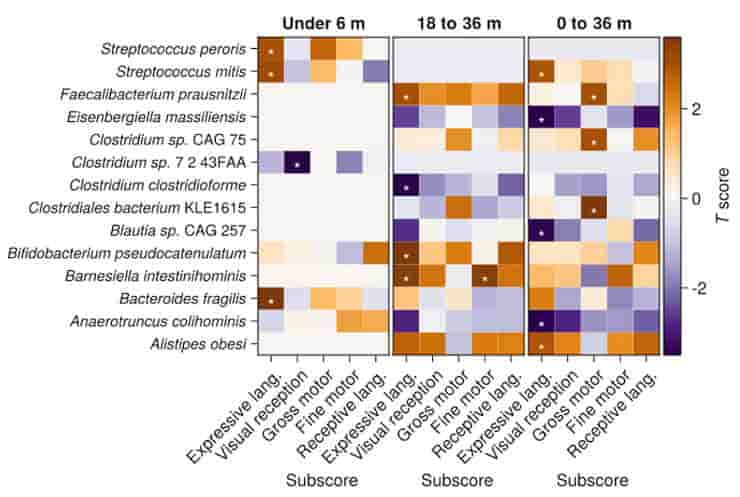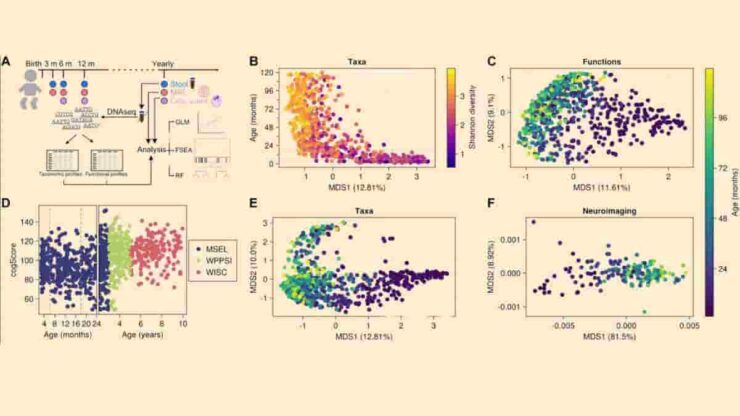Although emerging evidence links the gut microbiome to cognitive outcomes and neurodevelopmental disorders, the impact of gut microbial metabolism on ordinary neurodevelopment has not been fully explored. In partnership with other institutions, Wellesley College researchers have now found that changes in the gut microbiome are connected with general cognitive function and brain development in healthy children.
This study looks at this relationship in 381 healthy children who are all part of the RESONANCE cohort in Providence, Rhode Island, and offers new insights into early childhood development.
The cohort is part of the NIH’s Environmental Influences on Child Health Outcomes (ECHO) study and includes MRI scans, neurocognitive tests, biospecimen analyses, genetic information, broad environmental exposure data (like chemical, water quality, and nutrition), and extensive information about the person’s family, medical history, demographics, and socioeconomic background.
Specific gut microbial species, such as Alistipes obesi and Blautia wexlerae, are associated with higher cognitive functions. Conversely, certain species, like Ruminococcus gnavus, are more prevalent in children with lower cognitive scores.

In the youngest subset of individuals (0 to 6 months), the researchers found no statistically significant relationships between individual species and cognitive function. They suggest that this is due to the fact that brain developmental pathways begin in utero while microbial impacts, which can only begin at birth, take longer to show up.
The Microbiome and the Brain
For both the microbiome and the brain, the first years of life are critical developmental windows. The study emphasizes the importance of microbial genes, particularly those involved in the metabolism of neuroactive compounds such as short-chain fatty acids, in influencing cognitive abilities.
Advanced machine learning models demonstrated the capability of gut microbial profiles to predict variations in brain structure and cognitive performance, highlighting the potential for early detection and intervention strategies in neurodevelopment. This study represents an important first step in the understanding of the relationship between the gut biome and cognitive function in children.
“This research on a single cohort offers exciting hypotheses that we now want to test in additional settings,”
said corresponding author Vanja Klepac-Ceraj.
The authors also suggest that looking at the early-life microbiome and neurocognitive development in people from a variety of places and ways of life, including understudied groups like low-resource urban and rural communities, is important for future research.
Machine Learning Models
This is the first study to look at the gut-brain-microbiome axis in normal neurocognitive development in children. It is innovative in its use of multivariable linear and machine-learning models to investigate the intricate link between gut microbiome patterns and neurodevelopment.
These models not only established the association of gut microbiota with cognitive function but also predicted future cognitive performance based on early-life microbial profiles.
The findings lay the groundwork for the development of neurocognitive and brain development biomarkers. This research could lead to the early detection and correction of developmental disorders, potentially reducing long-term cognitive impairments.
It highlights the importance of gut health in early childhood, suggesting dietary and lifestyle considerations for parents and healthcare providers. Furthermore, this study marks the first step in formulating hypotheses that can be tested experimentally and in animal models.
Abstract
Emerging evidence implicates gut microbial metabolism in neurodevelopmental disorders, but its influence on typical neurodevelopment has not been explored in detail. We investigated the relationship between the microbiome and neuroanatomy and cognition of 381 healthy children, demonstrating that differences in microbial taxa and genes are associated with overall cognitive function and the size of brain regions. Using a combination of statistical and machine learning models, we showed that species, including Alistipes obesi, Blautia wexlerae, and Ruminococcus gnavus were enriched or depleted in children with higher cognitive function scores. Microbial metabolism of short-chain fatty acids was also associated with cognitive function. In addition, machine models were able to predict the volume of brain regions from microbial profiles, and taxa that were important in predicting cognitive function were also important for predicting individual brain regions and specific subscales of cognitive function. These findings provide potential biomarkers of neurocognitive development and may enable development of targets for early detection and intervention.
Reference:
- Kevin S. Bonham et al. Gut-resident microorganisms and their genes are associated with cognition and neuroanatomy in children. Sci. Adv. 9, eadi0497 (2023). DOI:10.1126/sciadv.adi0497
Top image: (A) Stool samples, cognitive assessments, and neuroimaging were collected from participants at different ages throughout the first years of life. (B) Cognitive function scores are assessed by different tests, but may be normalized using full-scale composite scores. (C and D) Principal coordinates analysis using Bray-Curtis dissimilarity on taxonomic profiles demonstrates high beta diversity, with much of the first axis of variation explained by increasing age and alpha diversity. MSEL, Mullen Scales of Early Learning; WPPSI, Wechsler Preschool & Primary Scale of Intelligence; WISC, Wechsler Intelligence Scale for Children. Differences in gene function profiles (E) and neuroimaging [principal components analysis (PCA) based on the Euclidean distance of brain region volumes] (F) are likewise dominated by changes as children age. Credit: Science Advances (2023). DOI: 10.1126/sciadv.adi0497
